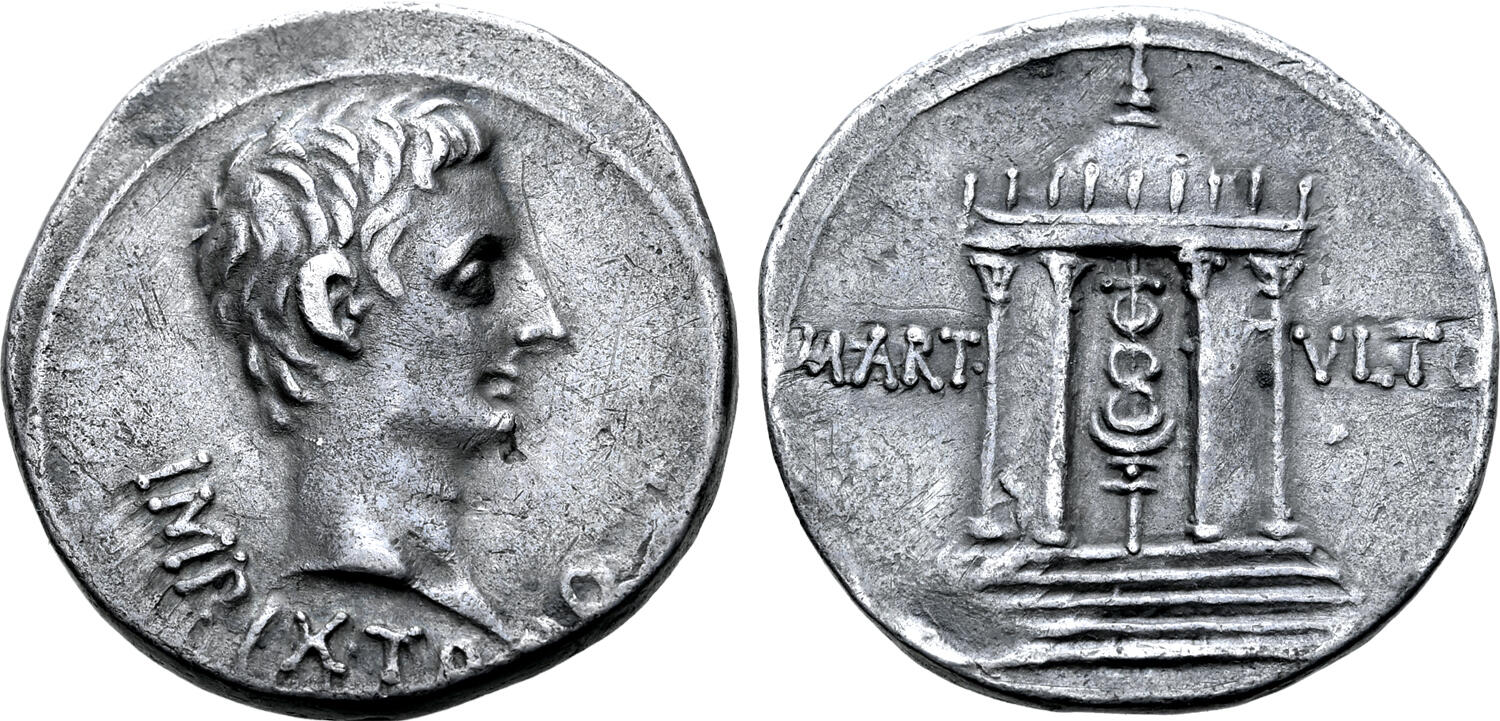Pergamum (Augustus), silver, cistophori (19-18 BCE)
From SILVER
19 BCE - 18 BCE Silver 24,907 kg
Description
| ObverseInscription or printing placed on the obverse.: | IMP•IX•TR•PO•V (Latin).Bare head to right |
| ReverseInscription or printing placed on the reverse.: | MART-VLTO across fields (Latin).Temple of Mars Ultor: circular, domed, tetrastyle temple set on five-tiered base, a signum within |
Mint and issuing power
| MintIdentifies the place of manufacture or issue of a numismatic object.: | Pergamum | Ancient regionAncient region.: | Mysia | Modern countryModern country: Turkey | AuthorityIdentifies the issuing power. The authority can be "pretended" when the name or the portrait of X is on the coin but he/she was not the issuing power. It can also be "uncertain" when there is no mention of X on the coin but he/she was the issuing power according to the historical sources: | Augustus (Roman emperor, 27 BC-14 AD), Roman Empire |
Chronology
| FromIdentifies the initial date in a range assigned in a numismatic context. | 19 BCE | toIdentifies the final date in a range assigned in a numismatic context.. | 18 BCE | PeriodTime period of the numismatic object.: Roman from 30 BC |
Physical description
| MetalThe physical material (usually metal) from which an object is made.: | Silver |
Median weightMedian of the weights of numismatic objects (in grams). in grams | 12.00 | DenominationTerm indicating the value of a numismatic object. Examples: tetradrachm, chalkous, denarius.: | cistophorus |
StandardStandard.: |
Image

S1931 Augustus cistophorus VII Pergamum.jpg [1]
References
| Die study referencePublication of the study: | Sutherland 19701Sutherland 1970, p. 73-84 (Group VII) | ||
| Coin series referenceReference to coin series study: | RIC I2RIC I, n° 507, RPC I3RPC I, n° 2220 | ||
| Coin series web referenceCoin series web references: | |||
Obverse dies distribution
| FrequencyFrequency of specimen in distribution. ᵖ | Number of obversesNumber of obverse dies. ᵖ (o) | % (o) | Number of coinsNumber of coins. (n) | % (n) | Die nameName(s) of the die(s). |
| 1 | 22 | 30.99 | 22 | 13.41 | 1, 7, 8, 11, 17, 22, 23, 24, 27, 28, 29, 32, 33, 34, 41, 43, 51, 55, 56, 67, 69, 70 |
| 2 | 25 | 35.21 | 50 | 30.49 | 2, 5, 6, 9, 13, 14, 15, 18, 20, 25, 26, 30, 40, 44, 46, 49, 50, 52, 53, 58, 60, 61, 62, 64, 71 |
| 3 | 17 | 23.94 | 51 | 31.1 | 3, 4, 10, 19, 21, 35, 36, 38, 39, 45, 47, 48, 54, 59, 63, 66, 68 |
| 4 | 1 | 1.41 | 4 | 2.44 | 42 |
| 5 | 1 | 1.41 | 5 | 3.05 | 65 |
| 6 | 3 | 4.23 | 18 | 10.98 | 16, 31, 37 |
| 7 | 2 | 2.82 | 14 | 8.54 | 12, 57 |
| Total | 71 of 71 | 100.01 | 164 of 164 | 100.01 |
Reverse dies distribution
no distribution is available
Quantification
| Number of obversesNumber of obverse dies. ᵖ (o) | 71 | Number of singletons (o1)The number of singleton coins. ᵖ | 22 |
| Number of reverse diesNumber of reverse dies. (r) | 136 | Number of coinsNumber of coins. (n) | 164 |
| Coins per obverse dieNumber of coins per obverse die. (n/o) | 2.31 | Coins per reverse dieNumber of coins per reverse die. (n/r) | 1.21 |
| Reverse per obverse ratioRatio of obverse dies divided by reverse dies. (r/o) | 1.92 | Percentage of singletons (o1)number of coins (n) divided by the number of singletons (o1) ᵖ | 30.99 % |
| Original number of dies (O) (Carter 1983 formula)The estimation of the number of coins according to Carter 1983 ᵖ | 103.78 | Coins struck if 20,000 as average productivity per dieCoins made if the average productivity for obverses (according to Carter) is 20,000. ᵖ | 2,075,600 |
| Original number of dies (O) (Esty 2011 formula)The estimation of the number of coins according to the singleton formula in Esty 2011 ᵖ (O) | 125.2 | Survival rate if 20,000 as average productivity per dieSurvival rate if average productivity is 20,000. ᵖ | 0.00008 |
| Coverage (o = % of O) (Esty 1984 formula)Esty 1984 - coverage (% of O) ᵖ (o = % of O) | 86.59% | Die productivity if survival rate 1/2,000Average productivity if survival rate is 1/2,000. ᵖ | 3,160.53 |
| Weight of silver (in kg) if 20,000 coins per die (O = Carter formula)Carter 1983 * Median weight * 20000 (*10 if gold or electrum) ᵖ | 24,907 kg <br /> 24,907 kg | Die productivity if survival rate 1/5,000Average productivity if survival rate is 1/5,000. ᵖ | 7,901.33 |
Remarks
Most likely one single workstation
References
- ^ Sutherland, C. H. V. (1970), The cistophori of Augustus, RNS Spec. Publ. 5, London, 134 p., 36 pl.
- ^ RIC I
- ^ Amandry, Michel - Burnett, Andrew - Ripolles, Pere Pau (1998), Roman provincial coinage. I. From the death of Caesar to the death of Vitellius (44 BC-AC 69), London-Paris, 2 vol., xvii + 812 p., 195 pl.